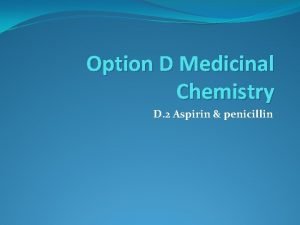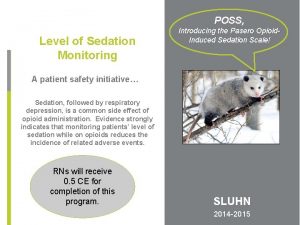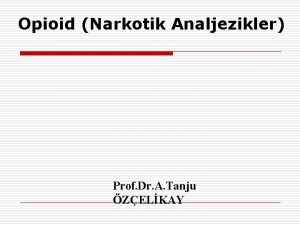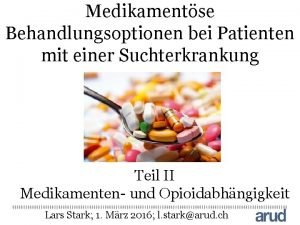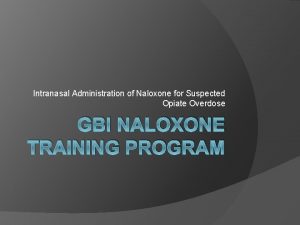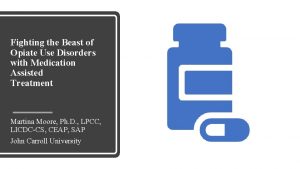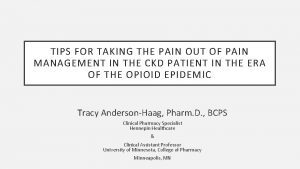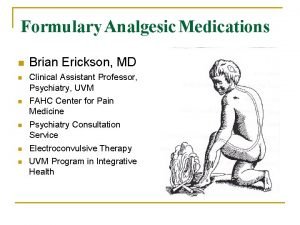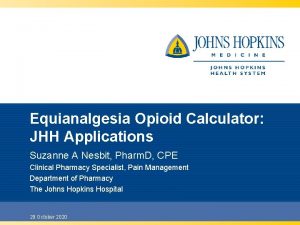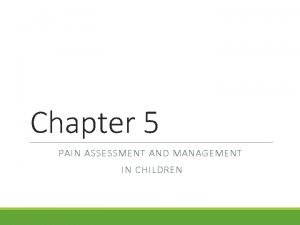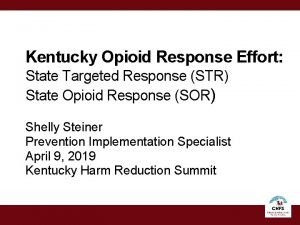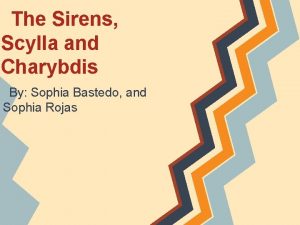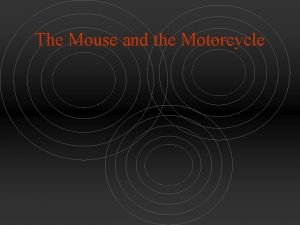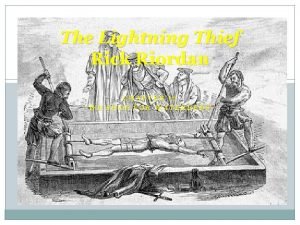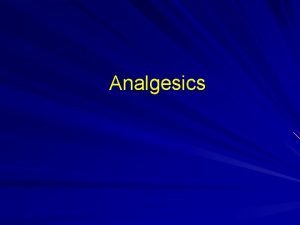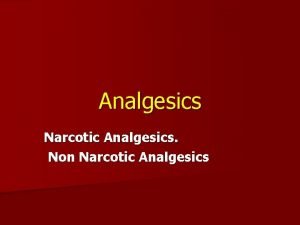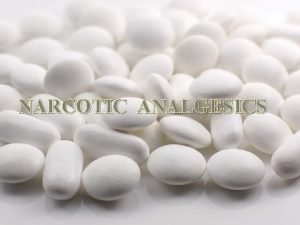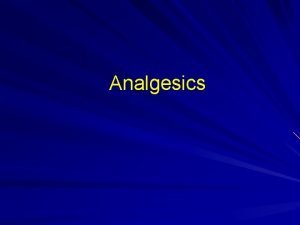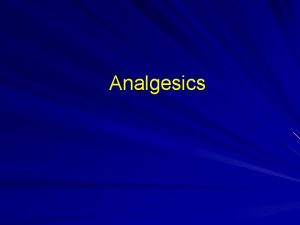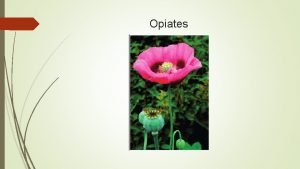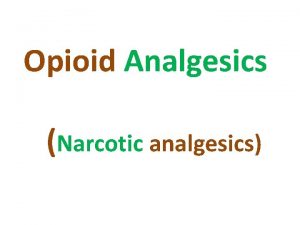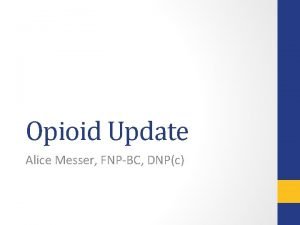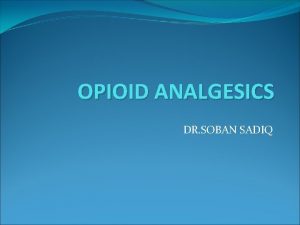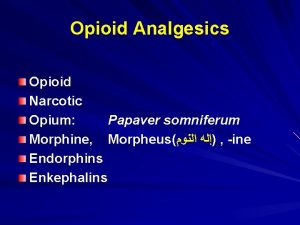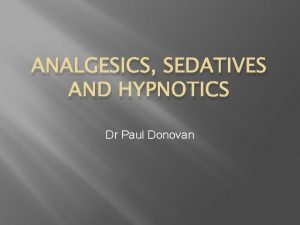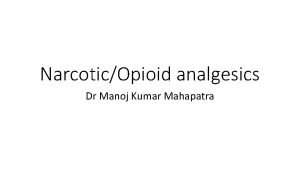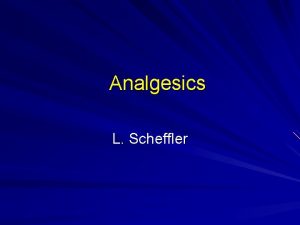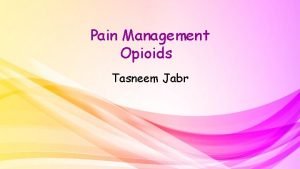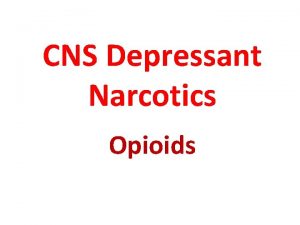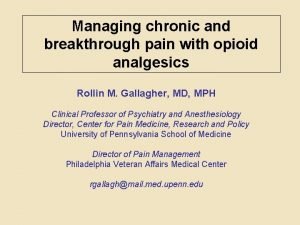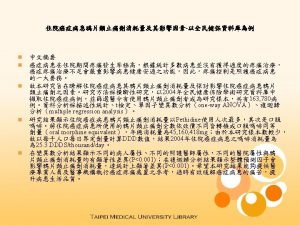OPIOID ANALGESICS Opioids Summary of opioid analgesics and


































- Slides: 34

OPIOID ANALGESICS

Opioids Summary of opioid analgesics and antagonists: Strong agonists: fentanyl, heroin, pethidine, methadone, morphine Moderate agonists: codeine Mixed agonist-antagonists: pentazocine Antagonists: naloxone, naltrexone

Mechanism of action �Activation of peripheral nociceptive fibers causes release of substance P and other pain-signaling neurotransmitters from nerve terminals in the dorsal horn of the spinal cord �Release of pain-signaling neurotransmitters is regulated by endogenous endorphins or by exogenous opioid agonists by acting presynaptically to inhibit substance P release, causing analgesia

Primary Effect of Opioid Receptor Activation �Reduction or inhibition of neurotransmission, due largely to opioid-induced presynaptic inhibition of neurotransmitter release �Involves changes in transmembrane ion conductance � Increase potassium conductance (hyperpolarization) � Inactivation of calcium channels

Three Opioid Receptors �Mu �Kappa �Delta

Delta Receptor �It is unclear what delta’s responsible for. �Delta agonists show poor analgesia and little addictive potential �May regulate mu receptor activity

Mu-Receptor: Two Types �Mu-1 �Located outside spinal cord �Responsible for central interpretation of pain �Mu-2 �Located throughout CNS �Responsible for respiratory depression, spinal analgesia, physical dependence, and euphoria

Kappa Receptor �Only modest analgesia �Little or no respiratory depression �Little or no dependence �Dysphoric effects

Opioid receptors

Opioid receptors 2. 1 Distribution and physiological effects: A Certain cells in the CNS: Brainstem: mediate respiration, cough, nausea and vomiting, maintain blood pressure, pupillary diameter and control of stomach secretions. Medial thalamus: modulate deep pain that is poorly localized and emotionally influenced.

Opioid receptors 2. 1 Distribution and physiological effects : A Certain cells in the CNS: Spinal cord: involved in the reception and integration of incoming sensory information and attenuate painful afferent stimulation. Hypothalamus: affect neuroendocrine secretion. Limbic system: influence emotional behavior.

Opioid receptors 2. 1 Distribution and physiological effects : B Periphery: --- Inhibit the release of excitatory, proinflammatory substances from nerve endings, which contribute to the antiinflammatory effect of opioids. C Immune cells: immune depression

Mainly agonist action atμreceptors, but some actions on other receptors • Morphine • Heroin • Codeine • Fentanyl ⊕ μ opioid receptor Analgesia Respiratory depression Euphoria/sedation Physical dependence Decreased GI motility Pupil constriction Agonist action at κreceptors, with partial antagonist action at μ receptors • Pentazocine ⊕ κ opioid receptor Analgesia Sedation/dysphoria Pupil constriction ⊕ opioid receptor Analgesia Antagonist act at μ, κ, receptors • Naloxone • Naltrexone

Efficacy high low Addiction/abuse Morphine Pethidine Methadone Fentanyl Codeine A comparison of the maximum efficacy and addiction/abuse liability of commonly used narcotic analgesics

Time to peak effect Duration of action Morphine Pethidine Fentanyl 20 min 4 hours 15 min 2 hours 5 min 45 min Time to peak effect and duration of action of several opioids administered intravenously

Morphine 4. 1 Pharmacological effects: A Analgesia: - Raises the pain threshold at the spinal cord level, alters nociception in the brain. - Relieves anxiety and fear B Euphoria: - Produces a powerful sense of contentment and wellbeing by stimulation of the ventral tegmentum.

Morphine C Respiration: - Causes respiration depression by reduction of the sensitivity of respiratory center neurons to carbon dioxide. D Depression of cough reflex: - May allow accumulation of secretions and thus lead to airway obstruction and atelectasis -Replaced by other safer antitussives.

Morphine E Miosis: - The pinpoint pupil is the characteristic of morphine use F Emesis: - Causes vomiting by stimulating the CTZ in the medulla but with no unpleasant sensations.

Morphine G Sedation: - Causes drowsiness and clouding of mentation, even disrupting sleep H Gastrointestinal effect: - Decreases motility of smooth muscle and increases tone, which causes constipation and increases pressure in the biliary tract (worsens abdominal colic, eg. Sphincter oddi contraction).

Morphine I Cardiovascular : - Has no major effects on the cardiovascular system. - Is usually contraindicated in individuals with severe brain injury (because that increased PCO 2 induced by respiration depression leads to cerebral vasodilation and consequential increase in cerebral blood flow and intracranial pressure). - Causes postural hypotension sometimes.

Morphine Therapeutic uses: A Analgesia: - Used for various pain, especially acute, obstinate constant pain (e. g. burn, cancer pain); - Fixed interval of administration reduces tolerance and dependence; - Severe pain of renal and biliary colic + MR blockers.

Morphine B Cardiac asthma: - Acute left ventricular heart failure induces pulmonary edema - Reduces anxiety, cardiac preload and afterload. - Particularly useful for painful myocardial ischemia with pulmonary edema. .

Morphine D Relief of cough: synthetic antitussives E Premeditate drugs before anesthesia : sedative, anxiolytic, and analgesic properties. For high-risk surgery administered systemically; for local (epidural) anesthesia. Caution: respiratory suppression

4. Morphine Adverse effects: - Respiratory depression - Vomiting, constipation, biliary colic - Dysphoria - Allergy-enhanced or postural hypotensive effects - Urinary retention (prostatic hypertrophy) - Elevation of intracranial pressure (head injury) - Immune depression

Morphine Tolerance and Physical Dependence �Repeated use produces tolerance to the respiratory depression, analgesic, euphoric and sedative effects, but not to pupil-constricting and constipating effects. �Physical and psychologic dependence readily occur for strong μagonists, especially used on necessities.

Morphine Tolerance and Physical Dependence �Withdrawal symptoms: a series of autonomic, motor and psychological response that incapacitate the individual (rhinorrhea, lacrimation, yawning, chills, gooseflesh, hyperventilation, hyperthermia, mydriasis, muscular aches, vomiting, diarrhea, anxiety, and hostility).

Morphine Contraindications: �Women during labor or lactation �New-born infants �Chronic obstructive pulmonary disease (COPD) �Asthma

Pethidine (meperidine) Actions and mechanisms: � Binds to opioid receptors, particularly receptor. � Actions similar to but less potent than morphine. ----Transient decrease of gastro-intestinal motility and increase of the tone ---- Indistinctly central depression of cough reflex.

Pethidine (meperidine) Therapeutic uses: � Analgesia: various severe pain, including during obstetric labor (less depression of respiration in newborn infants) � Cardiac asthma

Naloxone � Competitive blocker of opioid receptor, with ten-fold higher affinity for receptor than for . � Actions: --- precipitates withdrawal symptoms; ---reverses the coma and respiratory depression of opioid overdose (short action duration! Naltrexone with much longer action duration); --- eliminates some adverse effects with opioids

Other analgesics � Tramadol: weak receptor agonist, inhibits uptake of NA (noradrenaline) and 5 -HT (seratonin), effective on moderate to severe acute and chronic pain.


Questions ?

THANK YOU
 Mechanism of action of opioid analgesics
Mechanism of action of opioid analgesics Rachel beaty
Rachel beaty Analgesic classification
Analgesic classification Liquid gabapentin for cats dosage chart
Liquid gabapentin for cats dosage chart Poss scale vs rass scale
Poss scale vs rass scale Opioid antagonistleri
Opioid antagonistleri Opioid umrechnungstabelle
Opioid umrechnungstabelle Opioid overdose
Opioid overdose Opioid overdose
Opioid overdose Opioid overdose
Opioid overdose Types of pain
Types of pain Flacc pain scale
Flacc pain scale Opioid receptors location
Opioid receptors location Non-opioid
Non-opioid Opioid settlement calculator
Opioid settlement calculator Non-opioid
Non-opioid Kentucky opioid response effort
Kentucky opioid response effort Romeo and juliet summary act 4
Romeo and juliet summary act 4 Romeo and juliet act 4 scene 4 summary
Romeo and juliet act 4 scene 4 summary Warriors fire and ice summary
Warriors fire and ice summary Tops and bottoms summary
Tops and bottoms summary Difference between summary and abstract
Difference between summary and abstract Summary of chapters 12-15 in to kill a mockingbird
Summary of chapters 12-15 in to kill a mockingbird Who is ikemefuna things fall apart
Who is ikemefuna things fall apart Sirens scylla and charybdis
Sirens scylla and charybdis The reading public and the rise of the novel summary
The reading public and the rise of the novel summary The mouse and the motorcycle comprehension questions
The mouse and the motorcycle comprehension questions Georg simmel the metropolis and mental life
Georg simmel the metropolis and mental life The lion the witch and the wardrobe chapter 13 summary
The lion the witch and the wardrobe chapter 13 summary The lightning thief chapter 17 summary
The lightning thief chapter 17 summary Summary of chapter 8 and 9 the great gatsby
Summary of chapter 8 and 9 the great gatsby Theme of the great gatsby
Theme of the great gatsby Summary chapter 4 the great gatsby
Summary chapter 4 the great gatsby Act 3 of the crucible summary
Act 3 of the crucible summary Blind side poem
Blind side poem


